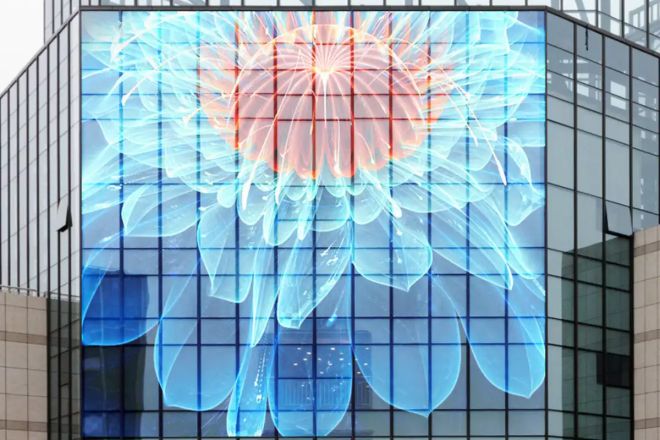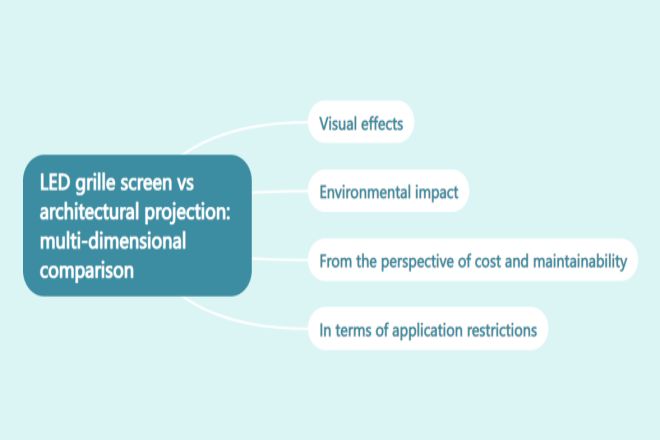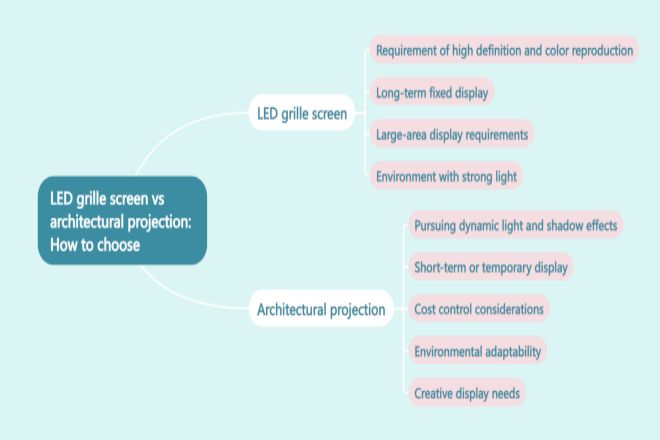Introduction

Standing at the foot of the skyscraper, looking up, I see that the bright sky composed of glass curtain walls is not only the scenery of the city but also the spark of collision between technology and art. LED grille screen and architectural projection, two visual wonders, are quietly changing our perception of architecture.
Imagine that at night, a seemingly ordinary glass curtain wall suddenly lights up. It is the LED grille screen with its unique transparent charm that makes the light and shadow perfectly blend with the building; or, a beam of light is projected on it, and the architectural projection with its infinite creativity turns the ordinary moment into a dream scene.
So, in this visual feast, who is the star that can touch your heart and light up the night sky of the city? Let us explore in depth together, unveil the mystery of LED grille screens and architectural projection, and find the best choice for building glass.
1. LED grille screen
LED grille screen, also known as curtain LED display, is a new display technology that uses an LED light source to project onto the screen surface to form a brightness change effect with side strip characteristics.
LED grille screen has multiple LED lights of different sizes built into it to form an overall display screen, thus forming a transparent three-dimensional strip pattern. In industry, it is also called grille screen, hollow screen, etc. It is an LED display screen with light strips as the basic unit, often installed on outdoor or indoor glass. The following are the main features of the LED grille screen:
- Lightweight and transparent:
The cabinet of the LED grille screen adopts an all-aluminum profile design, which is ultra-light and ultra-thin and can greatly reduce the weight and thickness of the entire display screen.
The hollow structure of the cabinet allows the LED grille screen to be light-permeable and air-permeable, increasing the visual effect and transparency. This design allows the LED grille screen to perfectly blend with the surrounding environment in the building curtain wall, building top, and outdoor advertising scenes, bringing people a new visual experience.
- High brightness and energy saving:
The LED grille screen has a high brightness, which can quickly attract people’s attention and improve the visibility and recognition of advertisements or logos.
The use of high-efficiency, high-brightness, good-quality LED lights and high-conversion-efficiency power supplies makes its average power consumption per hour relatively low, with the advantages of green energy saving.
- Strong protection:
The cabinet of the LED grille screen has a waterproof grade of IP65 and has multiple protection functions such as waterproof, dustproof, fireproof, low temperature, high temperature, lightning protection, and corrosion resistance, which can adapt to various harsh outdoor environments.
The highly protective design enables the LED grille screen to maintain a stable operating state in various harsh environments, providing a more reliable technical guarantee for outdoor display.
- Easy maintenance:
The structural design of the LED grille screen is simple and light, and it is very convenient to install and maintain.
- Front/rear maintenance can be achieved, reducing maintenance costs and difficulties. Diversified customization:
The cabinet of the LED grille screen can be customized in a variety of ways; whether it is round, square, or other special-shaped designs, it can be achieved through customized cabinets.
This gives the LED grille screen a wider application prospect in the field of outdoor display.
- High definition and resolution:
Although the specific resolution may vary depending on the product model and specifications, the LED grille screen usually has a higher definition and resolution and can present delicate and clear images and video effects.
- Strong wind pressure resistance:
Due to its reasonable structural design and excellent material, the LED grille screen has a strong wind pressure resistance and is suitable for use in outdoor environments.
2. Architectural projection
Architectural projection, also known as “architectural light and shadow show” or “holographic interactive” architectural projection, is an interactive imaging technology that combines digital multimedia technology with light and shadow technology.
It uses the surface of the building as a projection medium, and integrates 3D digital animation with wall projection media through projection technology to form a three-dimensional stereoscopic image, so that under the illumination of the light, the wall seems to “come alive” and show a variety of changes.
The characteristics of architectural projection mainly include the following aspects:
- Novel art form:
Architectural projection is a branch of new media art and new digital art that combines digital technology with artistic thinking. It is different from traditional art categories and elevates artistic expression to a new height through scientific and technological means.
The display information is rich in content, and the animation effect is three-dimensional and realistic.
Through the integrated coordination of sound, light, and electricity, a highly creative and artistic picture is created, which subverts the traditional sensory experience and gives people a shocking impact and enjoyment from a visual and psychological perspective.
- Innovative scientific and technological means:
Architectural projection integrates a variety of new media technologies, including multi-screen fusion technology, multi-surface correction technology, virtual reality technology, interactive technology, and other advanced technologies.
The application of these technologies has led to continuous innovation and development in architectural projection technology.
The combination of traditional projection equipment and advanced information technology provides software and hardware support for the realization of architectural projection, making the projection effect more accurate and delicate.
- Unique sensory experience:
Architectural projection combines visual, auditory, and other elements to create virtual physical illusions and a real sensory experience.
The image is projected in a complex three-dimensional space, which is more realistic and three-dimensional, matching the building structure and creating a visual illusion.
At the same time, architectural projection can also use sound, light, electricity and other technologies to create a surround sound effect, which is integrated with local history, culture and human stories to bring a full range of sensory enjoyment to the audience.
- Wide range of application scenarios:
Architectural projection can be applied to the facades of buildings, stage scenes, industrial products, indoor spaces, and other scenes.
Through projection technology, static buildings are awakened, allowing buildings to communicate with people in real life, achieving significant economic and social benefits.
For example, using architectural projection for publicity and display in large-scale events can attract the attention of a large number of audiences; using architectural projection to tell historical stories in tourist attractions can enhance the sense of participation and experience of tourists.
- (The above architectural projection video comes from D’Strict)
3. LED grille screen vs architectural projection: multi-dimensional comparison

When discussing the comparison between LED grille screen and architectural projection, we can conduct in-depth analysis from several aspects such as visual effects, environmental impact, cost and maintainability, and application limitations.
1). Visual effects:
LED grille screen, with its high brightness and high saturation LED lamp beads, shows extremely high color reproduction and clarity and can present delicate and vivid images and videos.
Its pixel points are densely distributed and support a high-resolution display, making the dynamic effects smooth and realistic.
In contrast, architectural projection can also show rich colors and dynamic effects, but its color reproduction and clarity may be affected by the projection equipment, light source quality, and ambient light, and there is a certain deviation.
2). Environmental impact:
The high brightness of the LED grille screen may cause light pollution in some cases, so it is necessary to reasonably control its brightness and irradiation range.
At the same time, its visual effect will also be affected by the surrounding light, especially in a strong light environment; the display effect may be weakened.
Architectural projection, with its soft light changes, has little impact on the surrounding environment, but when choosing the projection location, factors such as wall material, color, and ambient light need to be considered to ensure the best projection effect.
3). From the perspective of cost and maintainability:
The initial investment cost of an LED grille screen is relatively high, including equipment purchase, installation and construction, commissioning, and operation. However, its long-term maintenance cost is relatively stable, and as long as it is regularly maintained and maintained, it can maintain a good use state.
However, it should be noted that some maintenance work on LED grille screens may require high-altitude operations, which increases the difficulty and cost of maintenance.
In contrast, the initial investment cost of architectural projection is relatively low, but in the long-term operation process, it may be necessary to consider the maintenance cost of rental fees or equipment aging.
In addition, the maintenance of architectural projection is relatively simple, mainly focusing on the cleaning, dust prevention, and light source replacement of projection equipment.
4). In terms of application restrictions:
LED grille screen is more flexible in shape, size, and application scenarios. It can be customized according to actual needs to adapt to different architectural styles and decoration needs.
Whether it is commercial advertising, cultural and artistic exhibitions, or urban lighting projects, LED grille screens can show their unique charm. Architectural projection is more suitable for art displays in specific scenes, such as temporary exhibitions and festivals.
Its shape and size are limited by projection equipment and walls, so these factors need to be considered when choosing application scenarios.
4. LED grille screen vs architectural projection: How to choose?

When choosing between an LED grille screen and architectural projection, you should consider multiple factors such as specific application scenarios, visual effect requirements, cost budget, environmental adaptability, and maintenance convenience. Here are some guidelines to help you make a more appropriate choice in different situations:
1). Situations for choosing LED grille screen
- Requirement of high definition and color reproduction:
When the display content requires high definition and high color reproduction, an LED grille screen is a better choice. Its high brightness and high saturation can ensure the delicate presentation of image and video content.
- Long-term fixed display:
For scenes that require long-term fixed display, such as outdoor billboards, main visual walls in commercial exhibitions, etc., LED grille screens are more suitable due to their stability and durability.
- Large-area display requirements:
When large-area images or videos need to be displayed, LED grille screens can be flexibly spliced to achieve display requirements of any size, meeting the application of large venues, building curtain walls, and other scenes.
- Environment with strong light:
In direct sunlight or strong light environments, the high brightness characteristics of LED grille screens can ensure that the content is clearly visible and is not affected by ambient light.
2). Situations for choosing architectural projection
- Pursuing dynamic light and shadow effects:
Architectural projection creates unique visual effects through light and shadow changes and is suitable for occasions that require dynamic light and shadow effects and artistic atmosphere, such as festivals, art exhibitions, etc.
- Short-term or temporary display:
For short-term or temporary display needs, architectural projection has more advantages due to its flexible installation and easy replacement of content.
- Cost control considerations:
In the case of a limited budget, architectural projection may be a more cost-effective option. Although long-term operating costs may increase due to leasing or equipment updates, the initial investment is relatively low.
- Environmental adaptability:
In some special environments, such as ancient buildings and historical sites, the installation of LED grille screens may be restricted. At this time, architectural projection, as a non-invasive display method, can better adapt to environmental requirements.
- Creative display needs:
When it is necessary to attract the audience’s attention through creative displays, the flexibility and creativity of architectural projection make it the first choice. Through the customization and change of projection content, amazing visual effects can be created.
Conclusion
In summary, LED grille screens and architectural projections have their own advantages. They are not a simple replacement relationship but a relationship of mutual complementation and common development based on specific project needs and scene characteristics.
Therefore, when choosing the visual display method of building glass, we should comprehensively consider factors such as project requirements, budget, environmental protection requirements, and maintainability, and flexibly match LED grid screens and architectural projection technology to achieve the best visual effects and economic benefits.
Finally, if you want to know more about LED display screens, please get in touch with us.
